| Petru II Cercel | |
|---|---|
| Voivode of Wallachia | |
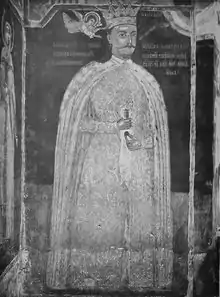 Petru Cercel at the Căluiu Monastery | |
| Voivode of Wallachia | |
| Reign | 29 August 1583 – 16 April 1585 |
| Predecessor | Mihnea Turcitul |
| Successor | Mihnea Turcitul |
| Died | March 1590 |
| House | Drăculești |
| Father | Pătrașcu cel Bun |
Petru II Cercel (Peter Earring or Earring Peter; c. 1545 – March 1590) was a Voivode (Prince) of Wallachia from 1583 to 1585, legitimate son to Pătrașcu cel Bun and alleged half-brother of Mihai Viteazul. A polyglot and a minor figure as a poet, Petru is noted for having written his verses in Tuscan.
In Europe
Petru spent his early years constantly traveling, trying to win support in his bid for the Wallachian throne. The fact that, as of 1579, he received unconditional support in France, coupled with the jewellery-wearing that attracted his moniker have led to speculations that Cercel belonged to the group of mignons of Henry III. It is even stated that Henry interceded with the Porte to award Petru the crown because of his affection for him.
Petru traveled to Istanbul in 1581, as constant backing by the French ambassador had influenced the Porte to look into matters; he arrived there in May, after being welcomed and spending time in Venice and Ragusa. His stay in the Ottoman capital was marked by a competition in bribing and intrigue, carried out against Ecaterina Salvaresso, mother to the child-voivode Mihnea (who was to be known as Mihnea Turcitul). Petru was to emerge the winner, with Mihnea and Ecaterina heading for a brief exile in Tripoli.
Members of the Drăculești line
Members of the House of Drăculești who held the throne of Wallachia include the following:
| Ruler | Remark |
|---|---|
| Vlad II Dracul | 1436–1442, 1443–1447; son of Mircea cel Bătrân |
| Mircea II | 1442; son of Vlad II |
| Vlad III Drăculea | 1448, 1456–1462, 1476; son of Vlad II |
| Radu cel Frumos | 1462–1473, 1474; son of Vlad II |
| Vlad Călugărul | 1481, 1482–1495; son of Vlad II |
| Radu cel Mare | 1495–1508; son of Vlad Călugărul |
| Mihnea cel Rău | 1508–1509; son of Vlad III |
| Mircea III Dracul | 1510; son of Mihnea cel Rău |
| Vlad cel Tânăr | 1510–1512; son of Vlad Călugărul |
| Radu de la Afumați | 1522–1523, 1524, 1524–1525, 1525–1529; son of Radu cel Mare |
| Radu Bădica | 1523–1524; son of Radu cel Mare |
| Vlad Înecatul | 1530–1532; son of Vlad cel Tânăr |
| Vlad Vintilă de la Slatina | 1532–1534, 1534–1535; son of Radu cel Mare |
| Radu Paisie | 1534, 1535–1545; son of Radu cel Mare |
| Mircea Ciobanul | 1545–1552, 1553–1554, 1558–1559; son of Radu cel Mare |
| Pătrașcu cel Bun | 1554–1558; son of Radu Paisie |
| Petru cel Tânăr | 1559–1568; son of Mircea Ciobanul |
| Alexandru II Mircea | 1568–1574, 1574–1577; son of Mircea III Dracul |
| Vintilă | 1574; son of Pătrașcu cel Bun |
| Mihnea Turcitul | 1577–1583, 1585–1591; son of Alexandru II Mircea |
| Petru Cercel | 1583–1585; son of Pătrașcu cel Bun |
| Mihai Viteazul | 1593–1600; son of Pătrașcu cel Bun |
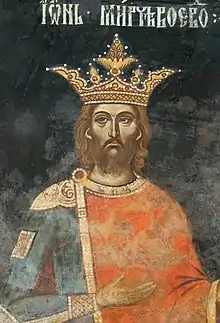
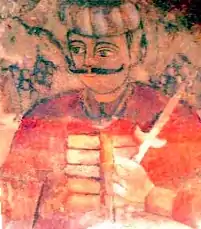 Vlad Dracul
Vlad Dracul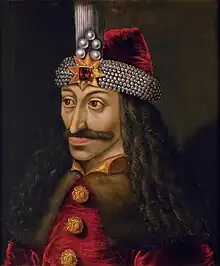 Vlad III the Impaler
Vlad III the Impaler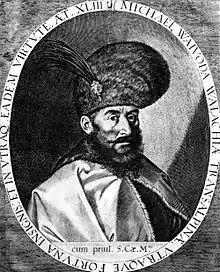
Reign
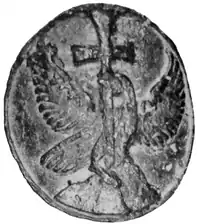
After a short stay in Adrianopole, the new Prince entered Bucharest on 19 August 1583, accompanied by a retinue of foreigners. Apparently, he aimed to replace some of the boyars with his own protegees: he ordered the killings of several Sfat members. At the same time, Petru increased taxes – this was motivated not only by his own large debt, but also by the fact that the throne was awarded to him on the condition not to cease payments owed by Mihnea (as Petru had waited to be awarded the throne, all debts had accumulated interest); on the side, the Prince also amassed a large personal fortune – more than half a million scudi by 1583.
He expanded and improved the Court in Târgoviște (largely ruined today), notably by adding (1584) the Casa Domnească (Princely House), a Renaissance-inspired small palace, by building a new wall and Princely church, and by introducing plumbing. Petru Cercel established a bronze cannon foundry in the city.
Downfall
The maneuvers of Mihnea and the hostility of certain Turkish beys attracted Petru Cercel's fall from grace. He managed to gather his fortune and flee the country on 6 April 1585, avoiding being taken into custody by the Ottoman kapucu. He arrived in Transylvania only to be arrested in Mediaș on Sigismund Báthory's orders after being deserted by his men. His belongings were confiscated and he was sent to prison in Maramureș.
In 1587, Petru managed to escape by sliding down a rope out the open window. He traveled to Warsaw and then to Vienna, reaching Rome (where he enlisted Pope Gregory XIV's support for his cause); Henry III reassured him of his protection, and Petru headed for Istanbul – arriving in the city in July 1589. He tried to profit from Mihnea's second fall from grace (and exile), but he proved to be a feeble opponent: as Mihnea regained the throne, Petru was imprisoned at Yedikule. Mihnea advanced large sums to have him killed by the Ottomans, in order to eliminate the threat. In March 1590, Petru Cercel was embarked on a ship, under the pretext of sailing to exile in Rhodes, and was decapitated on the spot.
Note
All dates are given in New Style format (see Adoption of the Gregorian calendar#Adoption in Eastern Europe).
External links
- (in Italian) Cristian Luca, Influssi occidentali sull’atteggiamento politico di alcuni principi dei Paesi Romeni nei secoli XVI e XVII
- (in French) Nicolae Iorga, Histoire des Roumains et de leur civilisation. Éléments de la civilisation roumaine à l'époque moderne
- (in Romanian) A presentation of the Medieval Princely Court of Târgoviște